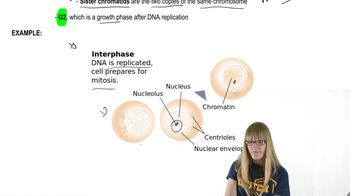In which step is the DNA replicated?
Table of contents
- 1. Introduction to Genetics51m
- 2. Mendel's Laws of Inheritance3h 37m
- 3. Extensions to Mendelian Inheritance2h 41m
- 4. Genetic Mapping and Linkage2h 28m
- 5. Genetics of Bacteria and Viruses1h 21m
- 6. Chromosomal Variation1h 48m
- 7. DNA and Chromosome Structure56m
- 8. DNA Replication1h 10m
- 9. Mitosis and Meiosis1h 34m
- 10. Transcription1h 0m
- 11. Translation58m
- 12. Gene Regulation in Prokaryotes1h 19m
- 13. Gene Regulation in Eukaryotes44m
- 14. Genetic Control of Development44m
- 15. Genomes and Genomics1h 50m
- 16. Transposable Elements47m
- 17. Mutation, Repair, and Recombination1h 6m
- 18. Molecular Genetic Tools19m
- 19. Cancer Genetics29m
- 20. Quantitative Genetics1h 26m
- 21. Population Genetics50m
- 22. Evolutionary Genetics29m
9. Mitosis and Meiosis
Mitosis
Problem 1b
Textbook Question
How do we know that DNA replication occurs during interphase, not early in mitosis?
 Verified step by step guidance
Verified step by step guidance1
Understand the question: The problem asks us to explain how scientists determined that DNA replication occurs during interphase and not during early mitosis. This involves understanding the experimental evidence and reasoning behind this conclusion.
Step 1: Recall the phases of the cell cycle. The cell cycle consists of interphase (G1, S, and G2 phases) and the mitotic phase (prophase, metaphase, anaphase, and telophase). DNA replication specifically occurs during the S phase of interphase.
Step 2: Review experimental evidence. Scientists used radioactive labeling experiments, such as incorporating tritiated thymidine (a radioactive form of thymine) into newly synthesized DNA. Cells were then observed under autoradiography to determine when DNA synthesis occurred.
Step 3: Analyze the results of these experiments. The radioactive labeling was detected in cells during interphase, specifically in the S phase, but not during mitosis. This provided direct evidence that DNA replication occurs before mitosis begins.
Step 4: Consider the reasoning. For mitosis to proceed correctly, the DNA must already be replicated so that each daughter cell receives an identical set of chromosomes. This functional requirement aligns with the experimental evidence that DNA replication is completed during interphase.
 Verified video answer for a similar problem:
Verified video answer for a similar problem:This video solution was recommended by our tutors as helpful for the problem above
Video duration:
1mPlay a video:
Was this helpful?
Key Concepts
Here are the essential concepts you must grasp in order to answer the question correctly.
DNA Replication
DNA replication is the process by which a cell duplicates its DNA before cell division. This occurs during the S phase of interphase, ensuring that each daughter cell receives an identical set of chromosomes. Understanding the timing of DNA replication is crucial for distinguishing between interphase and mitotic phases.
Recommended video:
Guided course

Steps to DNA Replication
Interphase
Interphase is the phase of the cell cycle where the cell prepares for division, consisting of G1, S, and G2 phases. During interphase, the cell grows, synthesizes proteins, and replicates its DNA. Recognizing interphase as the stage for DNA replication helps clarify why replication does not occur during mitosis.
Recommended video:
Guided course

Mitosis Steps
Mitosis
Mitosis is the process of cell division that results in two genetically identical daughter cells. It is divided into several stages: prophase, metaphase, anaphase, and telophase. Understanding that mitosis follows DNA replication in interphase is essential for grasping the overall cell cycle and the timing of genetic material distribution.
Recommended video:
Guided course

Mitosis Steps
Related Videos
Related Practice
Multiple Choice
633
views
5
rank


